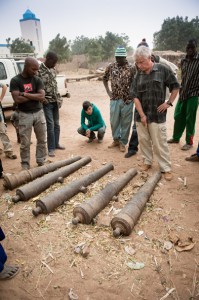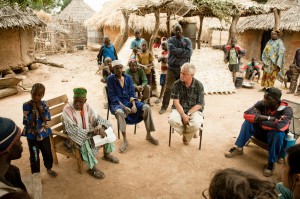A reconnaissance mission in December 1998-January 1999 in the Sanoukholé Valley led to the unexpected discovery of a group of cast-iron cannons older than the colonial period, deposited in the village of Farabana on the Malian side of the Falémé. The recent expansion of our program in the Falémé Valley has allowed us to return to this village and to further investigate this discovery.
Currently visible remains
During survey in 2012, we found five cast-iron cannons on the village plaza and two others in the concession of a family of a person of note. These cannons are all of mass class 1 (1 pound), their diameter at the muzzle measuring 53 mm. They belong to two different types. The first, with an average length of 136 cm and obviously the older, has the monograms XL and HB on the plates of the chase (tenon), the muzzle and breech button both molded, like the first and second reinforces with molded double bands and the reinforces of the cascabel (volée) and breech (culasse). The second type, slightly longer at 147 cm and perhaps more recent, is decorated with three fleur de lys on the barrel and the initials CI engraved on each side of the bore channel (canal de mise à feu). The initials CI may refer to the East India Company (Compagnie des Indes).
The inhabitants then took us 500 m north of the village to a small building in ruins, apparently square, 13 m to a side and 1.50 min preserved height. In their view, the cannons were removed from this building by Faidherbe in 1858.
European explorations prior to French arrival ?
Such early installations of Europeans in the continental interior, prior to colonization, are very little documented and structures unknown. They are not, however, the oldest in this region. Indeed, authors have repeatedly suggested a Portuguese presence in the border zone between Mali and Senegal during the 15th and 16th centuries. Assertion of such an early Portuguese presence in the heart of Africa, particularly in the Sanoukholé Valley, was only hypothetical and based mainly on the interpretation of early maps – mostly French and dating to the 17th century – and on accounts of the authors referring to one another for more than three centuries, with no specific source ever cited.
During our survey mission, an archaeological discovery and an oral tradition survey in the village of Farabana reopened the debate. First, on the surface of two sites found during field survey, we discovered two stone cannonballs marked by percussion impact, one of which is very likely to be of imported rock. The first is calibrated to 2 pounds (70 mm, 474 g) and the other to 1 pound (52 mm, 232 g). This kind of stone projectile, gradually abandoned during the last third of the 15th century and replaced by cast-iron cannonballs, may with reservation be the earliest material evidence of the presence of Westerners in the interior during the Age of Discovery. From our survey with the griot Kono Diabaté from Farabana, we also learned that, according to the people, two “white races” successively came to this area before colonization by General Faidherbe: the Portugeuse and then the French.


